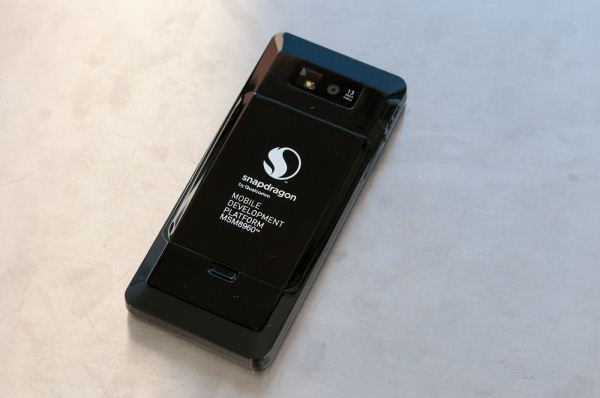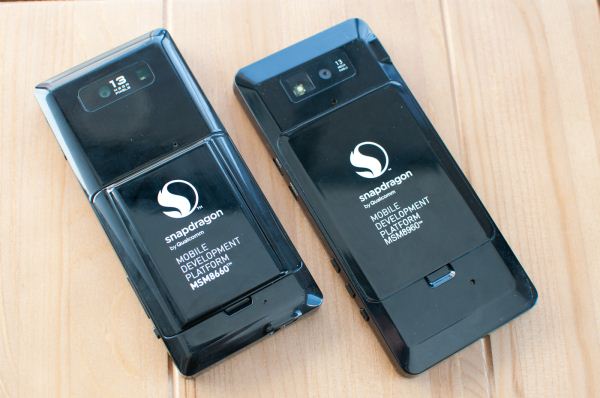Qualcomm Snapdragon S4 (Krait) Performance Preview - 1.5 GHz MSM8960 MDP and Adreno 225 Benchmarks
by Brian Klug & Anand Lal Shimpi on February 21, 2012 3:01 AM EST- Posted in
- Smartphones
- Snapdragon
- Qualcomm
- Adreno
- Krait
- Mobile
If you've been following our SoC and smartphone related coverage over the past couple of years, you'll probably remember how Qualcomm let us take home an MDP8660 from MWC 2011 and thoroughly benchmark it. Qualcomm has done essentially the same thing this year, this time sending their latest and greatest MSM8960 SoC inside the aptly named MSM8960 Mobile Development Platform (MDP) just before MWC 2012. The timing is impeccable as we're fully expecting to start seeing MSM8960 based phones next week at MWC, and we've been telling you to hold off on any smartphone purchases until the 8960's arrival. Today we're finally able to give you an indication of just how fast Qualcomm's next-generation Snapdragon S4 will be.
We've already been teased MSM8960 and Krait a few times, and have talked about the architecture and what to expect from the SoC itself. The super short recap is this: Krait is the name of Qualcomm's new out of order ARMv7-A compatible CPU architecture (previous generations of Snapdragon used Scorpion) which is designed for TSMC's 28nm process. Inside MSM8960 are two Krait cores running at up to 1.5 GHz, Adreno 225 graphics, improved ISP and Qualcomm's new baseband with support for nearly every air interface out there.
The MDP we were sampled is clearly a descendant of the MDP MSM8660 we were given last year, sharing the same black utilitarian look and purpose-built design, though it's notable that the new device is markedly thinner. MDP MSM8960 is running Android 4.0.3 at 1.5 GHz, and includes 1 GB of LPDDR2, and a 4" 1024x600 display. It's an interesting note to make that both Intel and Qualcomm have somehow settled on 1024x600 for their reference designs.
We also asked Qualcomm for a copy of the old MDP8660 for comparison purposes, just to see how far we've come since the first dual core Snapdragon SoC.
| Qualcomm Mobile Development Platform (MDPs) | ||
| MDP MSM8660 | MDP MSM8960 | |
| SoC | 1.5 GHz 45nm MSM8660 | 1.5 GHz 28nm MSM8960 |
| CPU | Dual Core Scorpion | Dual Core Krait |
| GPU | Adreno 220 | Adreno 225 |
| RAM | 1 GB LPDDR2 | 1 GB LPDDR2 |
| NAND | 8 GB integrated, microSD slot | 16 GB integrated, microSD slot |
| Cameras | 13 MP Rear Facing with Autofocus and LED Flash, Front Facing (? MP) | 13 MP Rear Facing with Autofocus and LED Flash, Front Facing (? MP) |
| Display | 3.8" WVGA LCD-TFT | 4.03" SWVGA (1024x600) LCD-TFT |
| Battery | 3.3 Whr removable | 5.6 Whr removable |
| OS | Android 2.3.2 (Gingerbread) | Android 4.0.3 (ICS) |
We're taking a look at just CPU, GPU, and power performance today on MSM8960, as cellular baseband is disabled on the MDP just like it was when we looked at the previous MSM8660 MDP. We'll get a chance to investigate that further in the future, again right now the key areas are CPU, GPU, and power.
As we talked about in the previous MDP piece, the purpose of the MDP is just to serve as a reference design for both Qualcomm to get its Android port running on, and also for individual developers to profile and test their applications against. It's analogous to TI's OMAP Blaze platforms - you won't ever likely see one out in the wild, but it's a reference target that the silicon vendor leverages to port Android, and a piece of hardware that OEMs can use as a reference when they start customizing and building handsets.
Just like last time the MDP also comes with a software build that lets us easily enable or disable vsync on the device, restart surfaceflinger, and then run benchmark tests. There's no such analog for shipping retail devices, only development builds contain this functionality. As there are parts of each benchmark that could instantaneously peak over vsync's 60 FPS on some of the shipping platforms we're comparing to, we're providing results with vsync on and off.
In addition, last time when we ran tests on the MDP MSM8660 I noted that the governor was set to "performance" mode, which means it doesn't adaptively change CPU frequency as a function of load - it was 1.5 GHz all the time. This time the MDP MSM8960 came running with the much more typical "ondemand" governor selected, which does scale CPU frequency as a function of load, so there's less of a concern about the lack of pauses while the CPU changes performance states making results non comparable.


















86 Comments
View All Comments
nbenedetto1998 - Tuesday, January 1, 2013 - link
Krait is a15 just built on the a9 nm process which is 32 nm I believe. The real A15 will be built on a 28nm process.sjael - Tuesday, February 21, 2012 - link
Would be great to put some Transformer Prime numbers next to it. You know, just for kicks...infra_red_dude - Tuesday, February 21, 2012 - link
Some numbers where it beats Tegra3 everywhere (almost):http://www.pcmag.com/article2/0,2817,2400409,00.as...
Loki726 - Tuesday, February 21, 2012 - link
I'd like to see a clock-for-clock comparison. Tegra 3's A9 is at 1.3ghz and Krait is at 1.5ghz here. I'd be interested to see what happens when A9 gets scaled down to 28nm, and whether or not Krait will still have an advantage.Wishmaster89 - Wednesday, February 22, 2012 - link
And what would you need 1.5Hhz A9 for at 28nm? A15 is much better than any A9, and will come at lower process nodes.Besides, you can see that 1.2Ghz Exynos is much slower than 1.5Ghz Krait so I don't think higher clock will change it.
LordConrad - Tuesday, February 21, 2012 - link
I want one of these in my next phone. My HTC Thunderbolt works great, but it's getting a bit dated.TedKord - Tuesday, February 21, 2012 - link
Being an Anandtech reader, you've gotta be rooted and have a custom rom slapped on. What do you have flashed on yours?LordConrad - Wednesday, February 22, 2012 - link
Right now I'm using the BAMF Forever ROM, nice features and very stable. I'll stick with it until I find something better (or get a new phone).ShieTar - Tuesday, February 21, 2012 - link
"At a lower resolution Apple's A5 is unable to outperform the Adreno 225 here."Actually, 960x640 and 1024x600 both have exactly the same number of total pixels.
Not that it changes the conclussion.
lowlymarine - Tuesday, February 21, 2012 - link
"At a lower resolution Apple's A5 is unable to outperform the Adreno 225 here."Perhaps I'm misreading this line, but aren't 1024x600 and 960x640 actually exactly the same resolution in different aspect ratios?